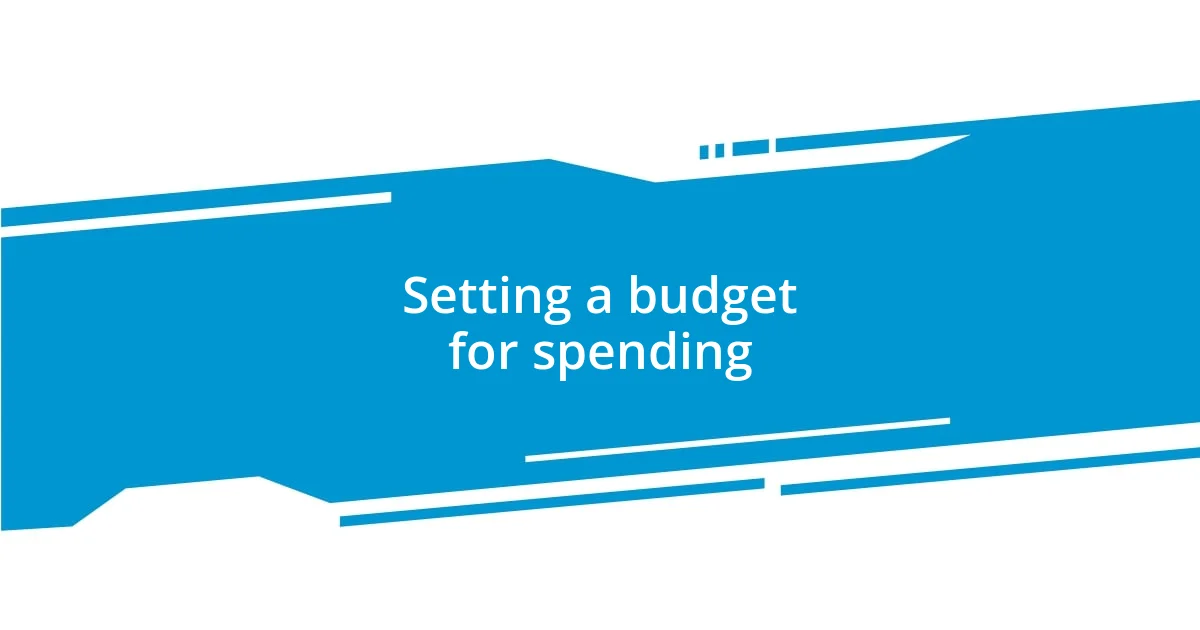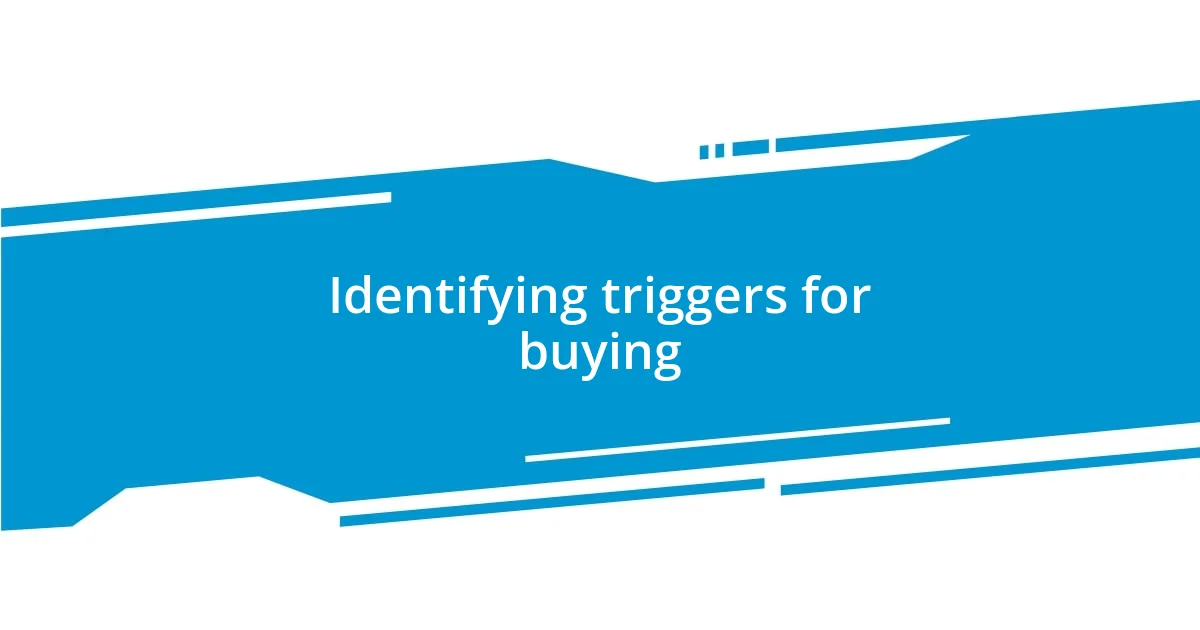Key takeaways:
- Understanding motivations behind purchases, including emotional states and social influences, helps individuals make intentional choices rather than impulsive ones.
- Implementing strategies such as setting budgets, waiting periods for purchases, and exploring alternatives, can significantly reduce unnecessary spending.
- Regularly reviewing and adjusting spending habits encourages mindfulness, leading to more fulfilling financial decisions and personal satisfaction.

Understanding the need for purchases
Understanding our need for purchases often starts with a simple question: what drives us to buy something? I remember a time when I impulsively bought a new jacket because it was trendy, but the reality was I was feeling a bit down that day. It’s fascinating how emotions can influence our spending habits, right?
Sometimes, we purchase out of necessity—like the new tire my car desperately needed after a nail took residence in the old one. But other times, it’s more about social influence or personal desires. I’ve found myself standing in a store, realizing that I’m not just buying a product; I’m chasing a feeling or a status. Isn’t it intriguing how a simple item can carry so much weight in our lives?
Ultimately, understanding our motivations is key. I’ve learned to pause and question my impulses: “Do I truly need this, or am I simply filling a void?” This reflection has become a powerful tool for me. It turns purchasing from a mindless act into a more intentional choice, steering away from unnecessary clutter in my life.

Setting a budget for spending
Setting a budget is one of the most effective ways to control spending. When I first started budgeting, I was surprised at how empowering it felt to allocate specific amounts for different categories. This approach not only clarified where my money was going but also helped me identify areas where I could cut back. I’ve experienced the satisfaction of sticking to my budget, knowing each dollar is contributing to my long-term goals.
Here are some key steps in setting a budget for spending:
- Track your current spending to see where your money goes each month.
- Identify fixed expenses (like rent or utilities) versus variable expenses (like dining out).
- Set realistic spending limits for each category based on your financial situation.
- Regularly review and adjust your budget as your financial circumstances change.
- Challenge yourself to find at least one area where you can reduce spending, even if it’s just a little bit each month.
Finding that balance can transform your approach to spending. For instance, I remember setting a limit for dining out and sticking to it for months. It not only saved me money but also encouraged me to cook more at home and experiment with new recipes. In the end, it became a rewarding experience—both financially and personally!

Identifying triggers for buying
Identifying triggers for buying often requires a bit of introspection. I once noticed that I tend to shop more when I’m bored or stressed. It was enlightening to realize that these emotional states could lead me to the nearest online store, looking for temporary satisfaction. A simple shopping trip can morph into a deeper exploration of what I truly need in those moments.
Another common trigger is social influence. Have you ever felt compelled to buy something just because your friends or family have it? I recall a time when I bought a popular gadget, even though I didn’t really need it. It was about fitting in more than the actual utility of the item. Recognizing these triggers allows me to pause and ask whether I’m purchasing out of desire or necessity.
Lastly, marketing tactics play a significant role in our buying behaviors. Sales promotions and limited-time offers can create a sense of urgency that makes it hard to resist. I used to fall for those flashy ads, but now, I’m more aware of how they’re designed to provoke impulsive decisions. By identifying these triggers, I can better manage my buying impulses and make choices that align with my values.
| Trigger | Example |
|---|---|
| Emotional State | Boredom leading to online shopping |
| Social Influence | Purchasing a trendy gadget to fit in |
| Marketing Tactics | Reacting to a limited-time sale |

Implementing a waiting period
Implementing a waiting period for new purchases has become one of my foundational strategies. Whenever I feel the urge to buy something, I commit to waiting at least 24 hours. This simple practice has given me space to reflect on whether I genuinely need the item or if it’s just a fleeting desire. For example, after feeling the pull to buy a sleek new gadget, I realized that I’d likely forget about it within a week—now, that’s eye-opening!
I still remember a time when I waited a week before splurging on an expensive jacket. Initially, I felt a rush of excitement thinking about it, but as each day passed, I recognized my wardrobe was already filled with similar options. Why was I about to spend money on something I didn’t truly need? That waiting period not only saved my wallet, but it also served as a powerful reminder of the satisfaction I found in exploring what I already owned.
This small pause can even trigger a more mindful approach to shopping. Have you ever purchased something, only to realize days later that it was impulse-driven? By taking a step back, I often find that many perceived “must-haves” lose their allure. This waiting game has taught me patience and, surprisingly, to appreciate the thrill of anticipation rather than instant gratification.

Exploring alternatives to new items
Exploring alternatives to new items often leads me to discover the treasures hidden in my own home. For instance, I recently found a charming vintage lamp tucked away in a storage box. I had completely forgotten about it! Realizing I didn’t need to buy a new light fixture gave me a sense of satisfaction and nostalgia—it reminded me of the stories that come with our belongings.
Borrowing or swapping items with friends can also be a delightful alternative. I once participated in a local book swap where I exchanged novels I’d already read for some fresh titles. Not only did this practice feel resourceful, but it also fostered a sense of community and connection. Have you ever thought about how sharing experiences with others can cultivate relationships while reducing consumption? It’s a win-win!
Additionally, I’ve started to embrace the idea of renting instead of owning for things I use only occasionally. When I needed a high-quality camera for a weekend trip, I opted to rent one instead of purchasing a new model. This choice not only saved me money, but it also alleviated the pressure of having to find a permanent home for an item I wouldn’t frequently use. By exploring these alternatives, I feel more satisfied with what I have and less trapped by the urge to buy new.

Tracking expenses and savings
Tracking my expenses and savings has been transformative in my journey to minimize unnecessary purchases. I use a budgeting app, which allows me to categorize my spending and gain insight into where my money is going each month. It’s astounding how quickly small purchases accumulate – I once realized I’d spent a small fortune on coffee over time! This awareness led me to brew my own at home, ultimately not only saving money but also enhancing my mornings.
I’ve also made it a habit to review my bank statements regularly. While it seems tedious, I’ve turned this into a monthly ritual, almost like going through my own personal story. Reflecting on my spending habits often sparks a realization—like that time I spent significantly on gym classes but barely went. I asked myself, “Am I really committed or just following a trend?” This question shifted my focus toward activities that truly bring me joy without the price tag.
Sometimes, I’ll jot down my savings goals where I can easily see them. Though it sounds simple, visual reminders motivate me to prioritize saving over spending. For instance, I set a goal to save for a memorable travel experience instead of buying that designer handbag I thought I wanted. When I caught myself wavering, I’d ask, “What will bring me more happiness—a fleeting purchase or an unforgettable adventure?” This perspective has made me more mindful about my spending choices and turned tracking into a rewarding practice.

Reviewing and adjusting habits
I find that reviewing my habits regularly is crucial to minimizing new purchases. During one of my reflections, I noticed how often I used to buy new workout clothes, convinced it would motivate me to hit the gym more often. But, after analyzing my spending, I realized I already owned plenty of activewear that still had tags on them! It was eye-opening and made me reconsider my approach to fitness motivation; now I focus on actually using what I have.
Adjusting my habits isn’t just about what I buy, but also how I approach my needs. For instance, I used to shop for home decor every time I felt bored or uninspired. Now, I challenge myself to rearrange my existing furniture or even repurpose items around the house. This not only breathes new life into my space but also satisfies that urge to refresh my environment without spending a dime. Have you ever thought about how making small changes with what’s already around you can create a new vibe?
Sometimes, I’ll set specific periods of “no shopping” challenges for myself. One month, I decided to go without buying anything new, and surprisingly, it pushed me to creatively solve problems without reaching for my wallet. When my favorite water bottle broke, instead of running to the store, I repurposed an old mason jar. This experience taught me resilience and resourcefulness while reinforcing the idea that sometimes, less truly is more. How could a little self-imposed restraint transform your purchasing habits?
















